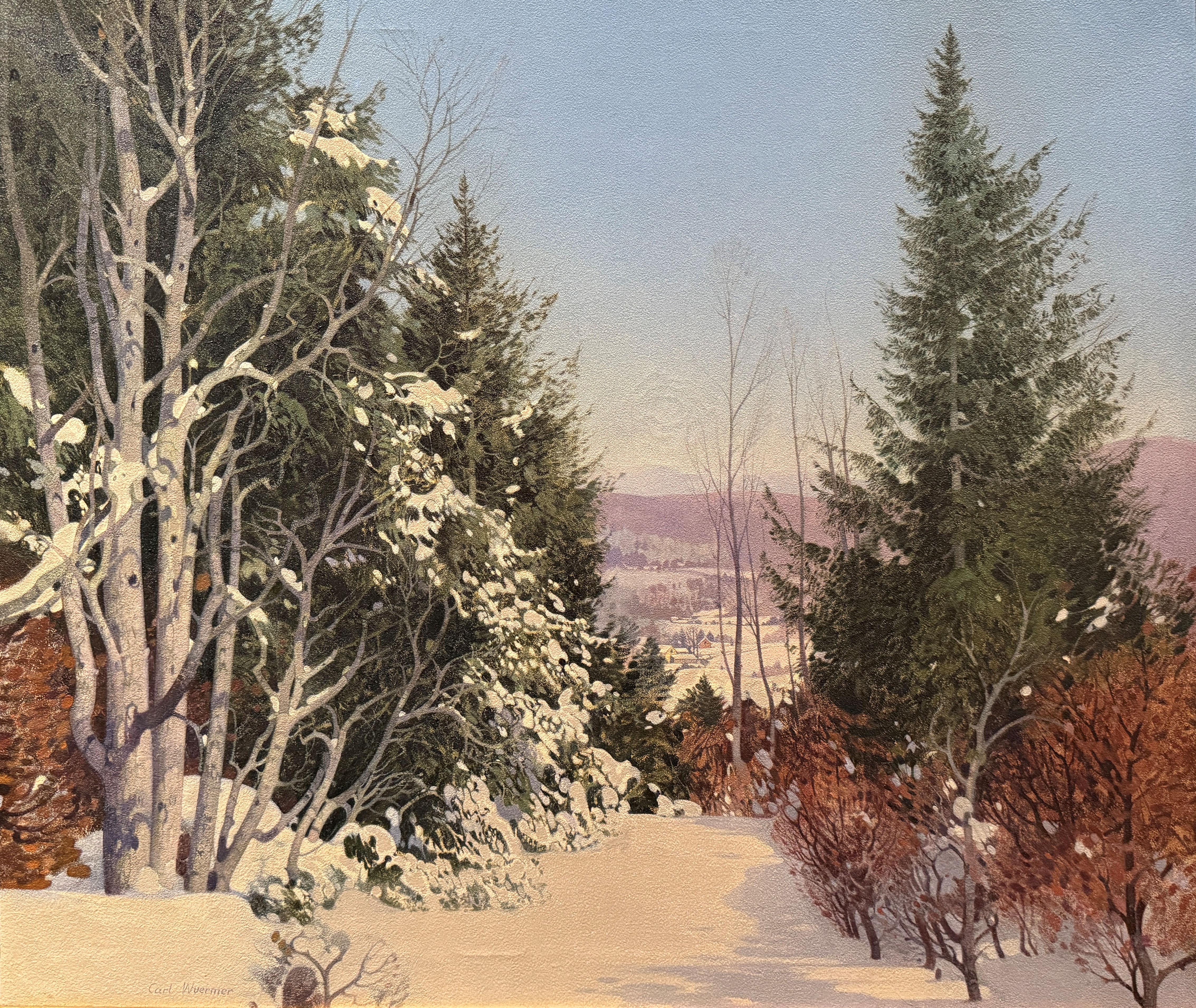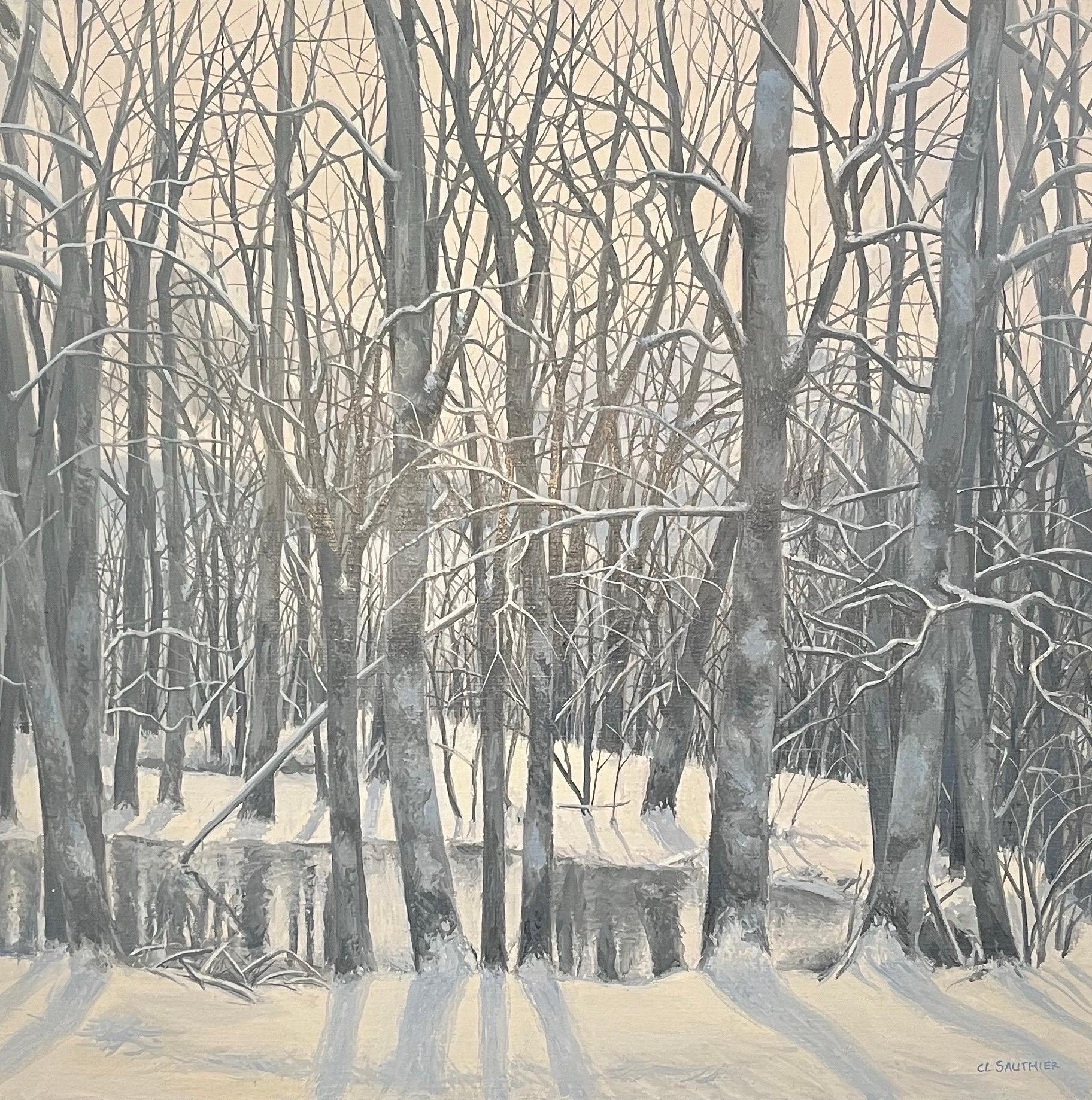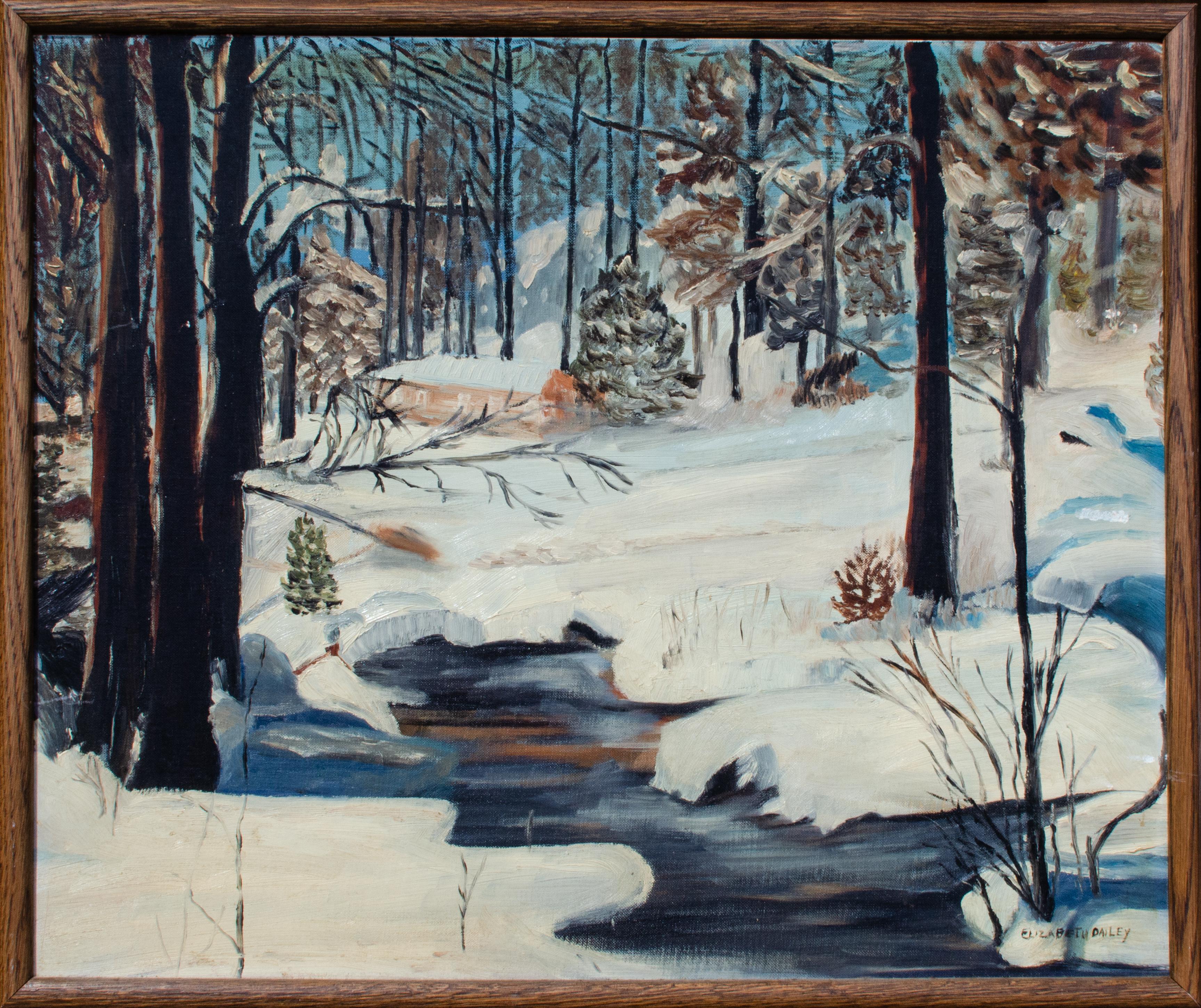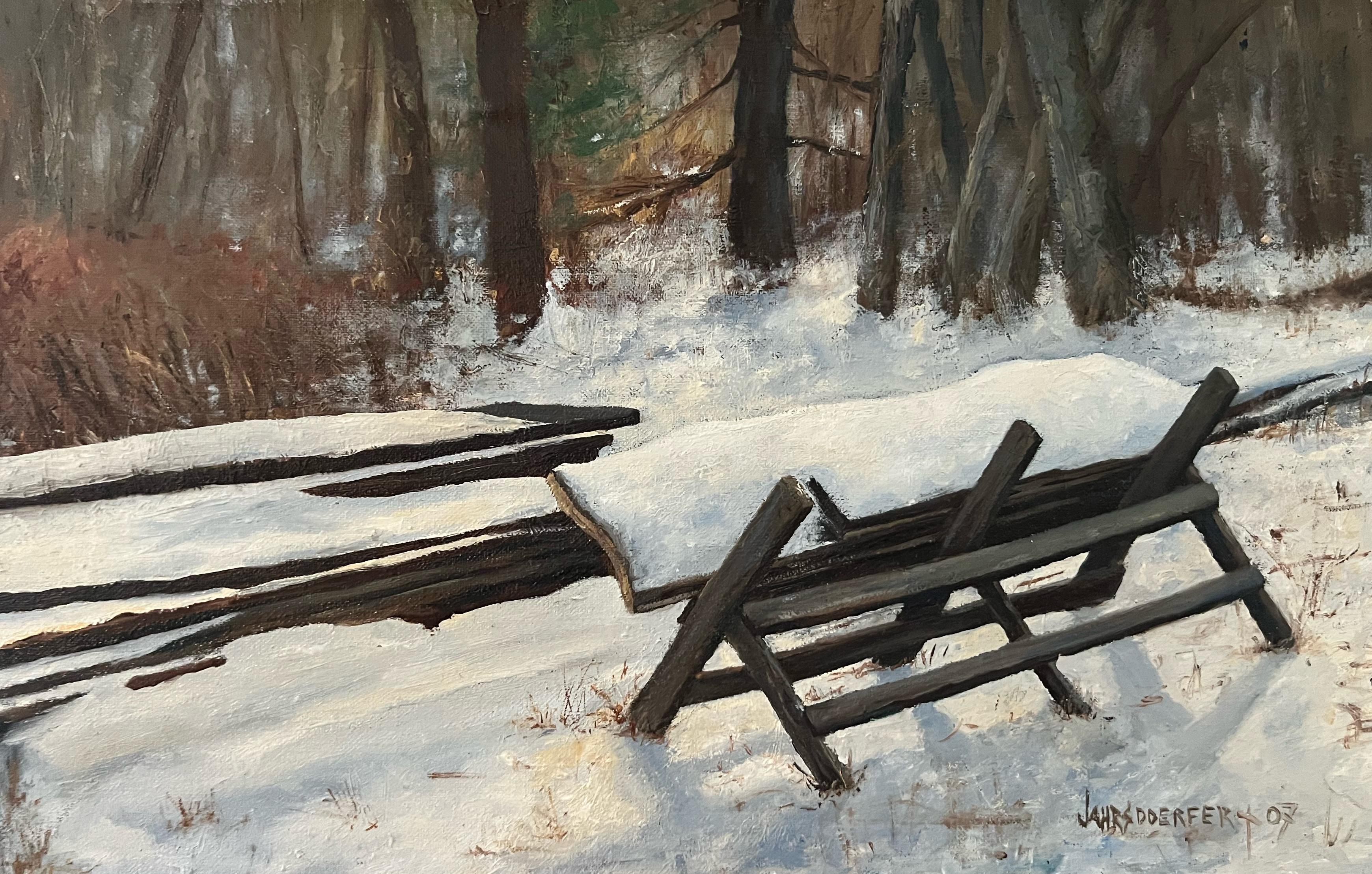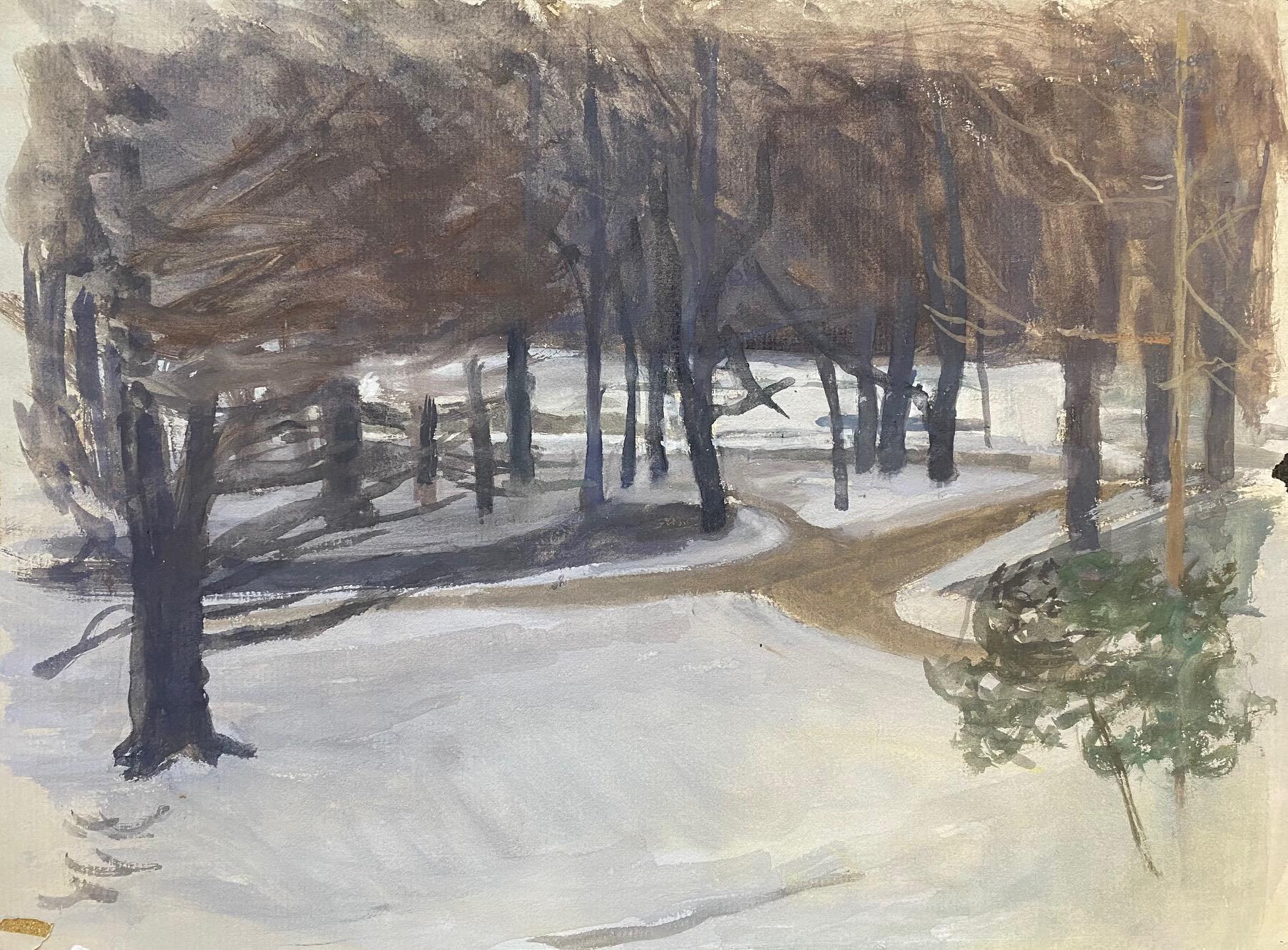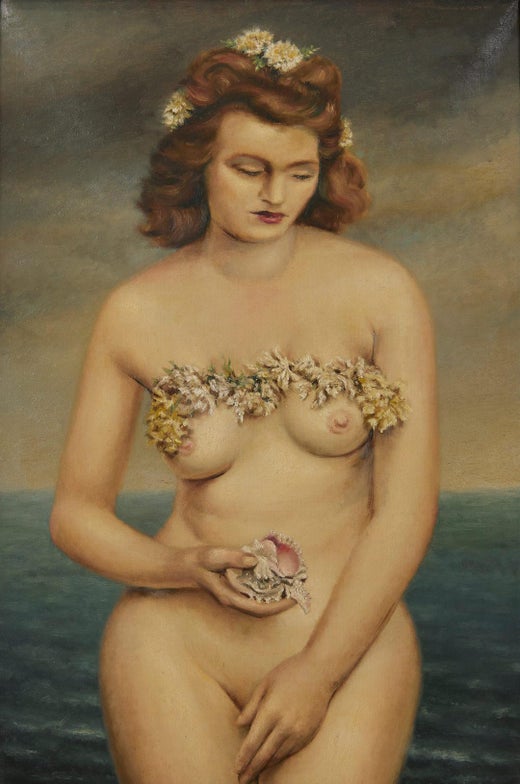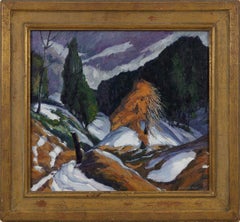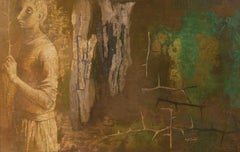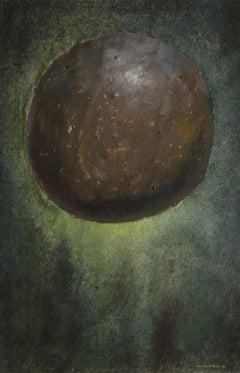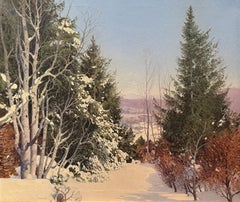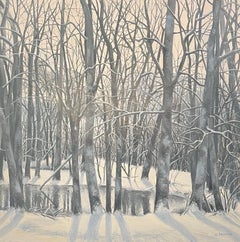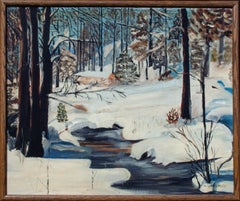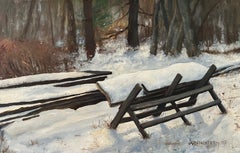Items Similar to Snow in Forest, Mid-Century Winter Landscape, Cleveland School Artist
Want more images or videos?
Request additional images or videos from the seller
1 of 11
Clarence Holbrook CarterSnow in Forest, Mid-Century Winter Landscape, Cleveland School Artist1945
1945
$13,750
£10,512.61
€12,108.40
CA$19,267.97
A$21,510.87
CHF 11,271.37
MX$263,314.19
NOK 143,146.56
SEK 134,969.03
DKK 90,366.23
About the Item
Clarence Holbrook Carter (American, 1904-2000)
Snow in the Forest, 1945
Watercolor on paper
Signed and dated lower right
19 x 23.75 inches
24 x 29 inches, framed
Clarence Holbrook Carter achieved a level of national artistic success that was nearly unprecedented among Cleveland School artists of his day, with representation by major New York dealers, scores of awards and solo exhibits, and streams of praise flowing from pens of the top art critics. Over the course of his 60+ year career Carter evolved from an exceptionally fine American Scene painter capable of evoking deep reservoirs of mood, into an abstractionist with a strongly surrealist bent.
While his two bodies of work seem at first to be worlds apart, owing to their different formal vocabularies, they, in fact, explore virtually the same subject: the nexus between life and death and the transition from earth to spirit. The early work finds its expressive power through specific people, events, and landscapes—most of which are drawn from his experiences growing up in the river town of Portsmouth, Ohio—while the later work from the 1960s on evokes potent states of being through pure flat shape, color and form that read as universals. As his primary form he adopted the ovoid or egg shape, endowing it with varying degrees of transparency. Alone or in multiples, the egg moves through Carter’s landscapes and architectural settings like a sentient spirit on a restless quest.
Born and raised in southern Ohio along the banks of the mercurial Ohio River and its treacherous floods, Carter developed a love of drawing as a child, and was encouraged by both his parents. He was self-directed, found inspiration all around him, and was strongly encouraged by the fact that his teenage work consistently captured art prizes in county and state fairs. Although money was tight after his father (who was a postal worker) died suddenly of a stroke, Carter’s mother supported his desire to study at the Cleveland School of Art from 1923-27, where he trained under painters Henry Keller, Frank Wilcox and Paul Travis.
In the summer of 1927, Carter studied in Capri with the modernist Hans Hofmann, where he carried out compositional exercises in charcoal and paint, recording the lucid spatial order of stairs, walls, roofs, arches and other elements of the island’s compressed architecture. Returning to Cleveland in 1929, Carter had his first solo show, and through Milliken taught studio classes at the Cleveland Museum of Art from 1930-37. In 1934, he worked under the auspices of the Public Works of Art Project and won a commission to paint two murals in Cleveland’s Public Auditorium. In 1936, he painted a post office mural in Ravenna, Ohio, as well as one for the post office in his hometown of Portsmouth, where his father had worked. He then headed the Northeast Ohio division of the painting projects arm of the Works Progress Administration, a subsequent government art program. In 1938, he moved to Pittsburgh to teach at the Carnegie Institute of Technology until 1944. Carter’s American Scene paintings of the ’30s and ’40s, which launched his artistic star, are the works for which the artist remains best known.
During and immediately after World War II, Clarence Carter realized his attraction to bold pattern, dramatic perspective and eye-catching hard-edged design was a poor fit with the prevailing style of Abstract Expressionism. Fortunately, these same hallmarks of his style were prized within the realm of commercial art. Thus, from 1944-1959, Carter became a veritable “Mad Man [Madison Avenue Man],” designing ambitious series of advertisements for major corporations such as Alcoa and The National City Bank of New York (Citibank) which appeared on the back covers of Fortune magazine, and on inside pages of Time, Newsweek, Business Week, and US News & World Report. Carter described this period of his life as one of incredible inventiveness and imagination. It freed him up to be far more experimental in his approach to image-making.
Around 1964 Carter acknowledged a need to break from the confines of representational painting. Once Carter had found a potent symbol in the egg, he used it to create an astounding body of imagery for the rest of his life. Among the most ambitious of all his later paintings were his Transections, a theological term meaning to cross, specifically between life and death.
- Creator:Clarence Holbrook Carter (1904-2000, American)
- Creation Year:1945
- Dimensions:Height: 19 in (48.26 cm)Width: 23.75 in (60.33 cm)
- Medium:
- Movement & Style:
- Period:
- Condition:
- Gallery Location:Beachwood, OH
- Reference Number:1stDibs: LU1768215492152
Clarence Holbrook Carter
Clarence Holbrook Carter achieved a level of national artistic success that was nearly unprecedented among Cleveland School artists of his day, with representation by major New York dealers, scores of awards and solo exhibits, and streams of praise flowing from pens of the top art critics. Over the course of his 60+ year career Carter evolved from an exceptionally fine American Scene painter capable of evoking deep reservoirs of mood, into an abstractionist with a strongly surrealist bent. While his two bodies of work seem at first to be worlds apart, owing to their different formal vocabularies, they, in fact, explore virtually the same subject: the nexus between life and death and the transition from earth to spirit. The early work finds its expressive power through specific people, events, and landscapes—most of which are drawn from his experiences growing up in the river town of Portsmouth, Ohio—while the later work from the 1960s on evokes potent states of being through pure flat shape, color and form that read as universals. As his primary form he adopted the ovoid or egg shape, endowing it with varying degrees of transparency. Alone or in multiples, the egg moves through Carter’s landscapes and architectural settings like a sentient spirit on a restless quest. Born and raised in southern Ohio along the banks of the mercurial Ohio River and its treacherous floods, Carter developed a love of drawing as a child, and was encouraged by both his parents. He was self-directed, found inspiration all around him, and was strongly encouraged by the fact that his teenage work consistently captured art prizes in county and state fairs. Carter studied at the Cleveland School of Art from 1923-27, where he trained under painters Henry Keller, Frank Wilcox and Paul Travis. Returning to Cleveland in 1929, Carter had his first solo show, and through Milliken taught studio classes at the Cleveland Museum of Art from 1930-37. In 1938, he moved to Pittsburgh to teach at the Carnegie Institute of Technology until 1944. Carter’s American Scene paintings of the ’30s and ’40s, which launched his artistic star, are the works for which the artist remains best known. During and immediately after World War II, Clarence Carter realized his attraction to bold pattern, dramatic perspective and eye-catching hard-edged design was a poor fit with the prevailing style of Abstract Expressionism. Fortunately, these same hallmarks of his style were prized within the realm of commercial art. Around 1964 Carter acknowledged a need to break from the confines of representational painting. Once Carter had found a potent symbol in the egg, he used it to create an astounding body of imagery for the rest of his life. Among the most ambitious of all his later paintings were his Transections, a theological term meaning to cross, specifically between life and death.
About the Seller
5.0
Vetted Professional Seller
Every seller passes strict standards for authenticity and reliability
Established in 1975
1stDibs seller since 2022
34 sales on 1stDibs
Typical response time: <1 hour
- ShippingRetrieving quote...Shipping from: Beachwood, OH
- Return Policy
Authenticity Guarantee
In the unlikely event there’s an issue with an item’s authenticity, contact us within 1 year for a full refund. DetailsMoney-Back Guarantee
If your item is not as described, is damaged in transit, or does not arrive, contact us within 7 days for a full refund. Details24-Hour Cancellation
You have a 24-hour grace period in which to reconsider your purchase, with no questions asked.Vetted Professional Sellers
Our world-class sellers must adhere to strict standards for service and quality, maintaining the integrity of our listings.Price-Match Guarantee
If you find that a seller listed the same item for a lower price elsewhere, we’ll match it.Trusted Global Delivery
Our best-in-class carrier network provides specialized shipping options worldwide, including custom delivery.More From This Seller
View AllScrub and Pines, Early 20th Century Landscape, Cleveland May Show Exhibition
By William Grauer
Located in Beachwood, OH
William C. Grauer (American, 1895-1985)
Scrub and Pines, 1929
Oil on canvas
Signed lower right
18 x 20 inches
24.5 x 26.5 inches, framed
Exhibited: Cleveland Museum of Art, May Show ...
Category
1920s Figurative Paintings
Materials
Oil
Nature Walk, Mid-Century Magic Surrealism, Cleveland School artist
By Hazel Janicki
Located in Beachwood, OH
Hazel Janicki (American, 1918-1976)
Nature Walk, 1960
Tempera on masonite
Signed lower left, dated and titled verso
18 x 28.5 inches
23.5 x 34 inches, framed
Hazel Middleton was bor...
Category
1960s Surrealist Figurative Paintings
Materials
Tempera
Departing from the System, Mid-Century Geometrical Abstract Mixed Media
By Clarence Holbrook Carter
Located in Beachwood, OH
Clarence Holbrook Carter (American, 1904-2000)
Departing from the System, 1961
Mixed media on paper
Signed and dated lower right
36 x 24 inches
A surrealist mid-century figural abst...
Category
1960s American Modern Abstract Paintings
Materials
Mixed Media
Winter Rooftops, Backyard Landscape, American Scene Cleveland School Artist
By Carl Frederick Gaertner
Located in Beachwood, OH
Carl Frederick Gaertner (American, 1898-1952)
Winter Rooftops, 1945
Oil on board
Signed and dated lower right
9.5 x 13 inches
17 x 20.5 inches, framed
Carl Gaertner was one of the g...
Category
1940s Landscape Paintings
Materials
Oil
Transection w/ Architectural Forms, Geometrical Figurative Abstract Acrylic
By Clarence Holbrook Carter
Located in Beachwood, OH
Clarence Holbrook Carter (American, 1904-2000)
Transection with Architectural Forms, c. 1980s
Acrylic and graphite on board
12 x 20 inches
A surrealist mid-century figural abstract ...
Category
1980s American Modern Abstract Paintings
Materials
Acrylic, Graphite
Night Garden, mid-century figural surrealist acrylic painting, Cleveland School
By Clarence Holbrook Carter
Located in Beachwood, OH
Clarence Holbrook Carter (American, 1904-2000)
Night Garden, 1972
Acrylic on scintilla
Signed and dated lower right
21.5 x 21.5 inches
24.25 x 24.25 inches, framed
Clarence Holbroo...
Category
1970s American Modern Figurative Paintings
Materials
Acrylic
You May Also Like
"Winter Silence" Carl Wuermer, American Impressionism Quiet Snowy Landscape
By Carl Wuermer
Located in New York, NY
Carl Wuermer
Winter Silence
Signed lower left
Oil on canvas
25 x 30 inches
Known for serene, realistic landscapes, he was a widely exhibited painter who won numerous awards includi...
Category
1920s American Impressionist Figurative Paintings
Materials
Canvas, Oil
"Snowy Forest" by Claude Sauthier - Oil on canvas - 60x60 cm
Located in Geneva, CH
Claude Sauthier was born in Geneva, Switzerland, in 1929 and passed away in the same city in 2016. He studied at the Geneva School of Decorative Arts and initially worked as a graphi...
Category
1970s Modern Landscape Paintings
Materials
Oil
Cabin in a Snowy Forest by American artist Elizabeth Dailey
Located in New York, NY
Elizabeth Dailey
Untitled, c. 20th Century
Oil on board
Sight: 19 1/2 x 23 1/2 in.
Framed: 21 x 25 x 1 in.
Signed lower right: Elizabeth Dailey
This lovely painting by an American a...
Category
20th Century American Modern Landscape Paintings
Materials
Oil, Board
James Jahrsdoerfer, "Woodsy Snow", 11x17 Winter Forest Landscape Oil Painting
Located in Saratoga Springs, NY
This piece, "Woodsy Snow", is an 11x17 oil painting on canvas by artist James Jahrsdoerfer featuring a winter view into a snow covered forest. A wood cradl...
Category
Early 2000s Landscape Paintings
Materials
Oil
"Winter" American Modernism WPA Regionalism Landscape Mid-Century Magic Realism
By Dale Nichols
Located in New York, NY
"Winter" American Modernism WPA Regionalism Landscape Mid-Century Magic Realism. 30 x 40 inches. Oil on canvas, c. 1960s, Signed lower right.
As we list the painting now, the work is currently being cleaned, restored and a hand carved frame is being built. Additional photos will be uploaded as soon as possible.
Our gallery, Helicline Fine Art, just launched our new digital exhibition: American Art: The WPA and Beyond. Three dozen paintings, works on paper and sculptures which are available here on 1stDibs. In person viewings can be arranged by appointment at our midtown Manhattan gallery.
Provenance:
"Winter" was originally purchased by Stanley Byer. Mr. Byer owned homes in Key West, New York City, and Washington, D.C. He purchased the painting from Dunning Auction in 1984 in Elgin, Illinois. Mr. Byer was related to Abraham Weiss from Florida. Saul Babbin, now deceased was a cousin of Mr. Weiss. I purchased the painting from Joy Babbin, Mr. Babbin's wife, now living in from New Mexico.
Dale Nichols (1905 – 1995) Artist, printmaker, illustrator, watercolorist, designer, writer and lecturer, Nichols did paintings that reflected his rural background of Nebraska where he was born in David City, a small town. Although he did much sketching outdoors, most of his paintings were completed in his studio and often included "numerology, magic squares...
Category
1960s American Modern Landscape Paintings
Materials
Canvas, Oil
Snowy undergrowth
Located in Geneva, CH
Work on paper without frame
Category
1960s Modern Landscape Drawings and Watercolors
Materials
Gouache
$256 Sale Price
57% Off
More Ways To Browse
Works In Progress
Mid Century Architectural Drawing
Cleveland School
Winter Snow Scenes
Vintage Fortune Magazines
Watercolor Winter Scenes
Snow River
Hans Harders
Mid Century Mother And Child Art
Southern Cross
Watercolor Snow Scene
Mid Century Hard Edge Painting
Winter River Scene
Snow Winter Landscape Drawing
1904 Worlds Fair
Mad Magazine
Vintage Cross Pens
Mid Century Modern Winter Scene
